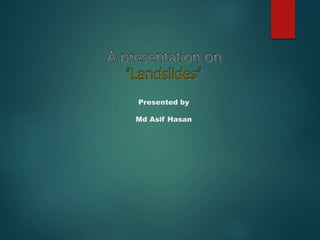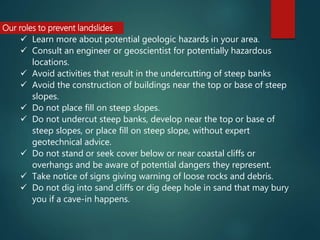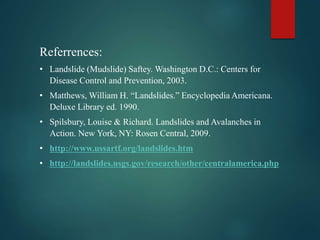Landslides
- 1. Presented by Md Asif Hasan
- 2. A landslide is the movement of a mass of rock, debris or earth down a slope (Cruden, 1991). More specifically, it is a catastrophic event where a block of earthen mass slides downhill which includes a wide range of ground movement, such as rock falls, deep failure of slopes and shallow debris flows, which can occur in offshore, coastal and onshore environments.
- 3. Causes of Landslides Geological causes Weathered materials Jointed or fissured materials Discontinuities Material contrasts Rainfall and snow fall Earthquakes Working of machinery Morphological causes Slope angle Uplift Rebound Wave erosion Glacial erosion Erosion of lateral margins Slope loading Physical causes Intense rainfall Rapid snow melt Rapid drawdown Freeze-thaw Ground water changes Soil pore water pressure Surface runoff Anthropogenic causes Loading Drawdown Land use change Water management Mining Vibration Water leakage Deforestation
- 4. Classification: Sharpe's classification (1938) The Well known is Sharpe's classification (1938), made on type of movement and type of material.
- 5. Major Types of Landslides Debris flow: Slope material that becomes saturated with water may develop into a debris flow or mud flow. The resulting slurry of rock and mud may pick up trees, houses and cars, thus blocking bridges and tributaries causing flooding along its path.
- 6. Earth Flow: Earthflows are downslope, viscous flows of saturated, fine- grained materials, which move at any speed from slow to fast. Typically, they can move at speeds from 0.17 to 20 km/h. Debris Avalanche: A debris avalanche is a type of slide characterized by the chaotic movement of rocks soil and debris mixed with water or ice (or both). They are usually triggered by the saturation of thickly vegetated slopes.
- 7. Rock Falls: are movements in which masses of rock or other material fall freely from cliff or steep slope through the air, and may bounce and roll. Earthquakes commonly trigger this final type of movement. Topple: Topple is the end-over- end motion of rock down a slope. In this, mass rotates forward about some pivot point. If a toppling mass pivots far enough, a fall may result.
- 8. Creep: This is the gradual movement of slope materials down the slope. Block slides: most common on steep slopes (roadcuts, valleys) velocities of 100+ miles per hour
- 9. Historical Landslides in Bangladesh Landslides in Bangladesh
- 10. Occurrence: Chittagong & Chittagong hill tracts Hill Ranges of Northeastern Sylhet Hill along the narrow northern strip of Mymensingh. ***Chittagong hill tracks have most frequent landslide The bedrock and soil structure of these hills are not stable, for which reason these areas are highly prone to landslide.
- 11. Statistics of causalities in Chittagong, Cox’s Bazar, Bandarban and Rangamati
- 12. Statistics of causalities in CTG over 18 years
- 13. Since 1997, landslides have caused the death of nearly 235 people in various informal settlements within Chittagong city and its adjacent small urban centers. Different studies show that approximately 500,000 impoverished people are currently living in informal settlements on the risky foothills of Chittagong city. High Risk Areas Lebubagan Area Baizid Bostami Area Kushumbag Residential Area Batali Hill Area Motijharna Area Landslide Vulnerability in Chittagong
- 14. Effect of Landslides: Short term effect: Property Damage Human loss Affects all resources, such as power supply, water supply, hospital, school , and many other things Long term effect: Loss of property value disruption of transportation route Loss of forest Water availability, and quality also affected
- 15. Minimizing the effects of Landslides: By geological mapping, detecting slope hazards and determining the likelihood of landslide occurrence, geoscientists can assist engineers, developers, planners and building inspectors in avoiding high-risk areas. Structures such as homes, schools, hospitals, power-lines, fire stations and roads can be safely located away from potential landslide risk areas. Mapping of landslide vulnerability that can help with the development of emergency response scenarios. Engineering and geotechnical investigation that define the landslide hazard and risk at site specific levels of investigation.
- 16. Stability of landslide: Covering the landslide with an impermeable membrane Directing surface water away from the landslide Draining ground water away from the landslide Minimizing surface irrigation.
- 17. Approaches for mitigation: Restricting development in Landslide prone area Codes for excavation, construction Protecting existing developments Monitoring and warning system Landslide insurance and compensation for losses
- 18. Mitigation measures- Prepare a landslide inventory map of the area which help to develop emergency scenario Implementation of regional hazard and risk assessment into land planning policies. Engineering and Geotechnical investigations that define the landslide hazard and risk at sites specific levels. Proper Drainage
- 19. Our roles to prevent landslides Learn more about potential geologic hazards in your area. Consult an engineer or geoscientist for potentially hazardous locations. Avoid activities that result in the undercutting of steep banks Avoid the construction of buildings near the top or base of steep slopes. Do not place fill on steep slopes. Do not undercut steep banks, develop near the top or base of steep slopes, or place fill on steep slope, without expert geotechnical advice. Do not stand or seek cover below or near coastal cliffs or overhangs and be aware of potential dangers they represent. Take notice of signs giving warning of loose rocks and debris. Do not dig into sand cliffs or dig deep hole in sand that may bury you if a cave-in happens.
- 20. Things to do if a home is suspected as being at risk for Landslide Danger: Get a ground assessment of your property. Minimize home hazards Plant ground cover on slope and build retaining walls. In mudflow areas, build channels or deflection walls to direct the flow around buildings. Learn to recognize the landslide warning signs Make evacuation plans Develop an emergency communication plan in case family member get separated
- 21. Action to be considered after a landslide: Avoid the landslide area as much as possible. There may be a danger of additional slides Check for injured or trapped persons near the slide area. Survival is more likely to occur near the slide periphery. Provide first aid to injured persons and activate emergency medical services if necessary. Report the event to your local fire, police, or public works department. Inform and assist affected neighbors, especially those who may require special assistance such as infants, the elderly, or person with disabilities. Listen to a radio or television for the latest emergency information. Watch for flooding, which may occur after a landslide or debris flow. Support the local government
- 22. Referrences: • Landslide (Mudslide) Saftey. Washington D.C.: Centers for Disease Control and Prevention, 2003. • Matthews, William H. “Landslides.” Encyclopedia Americana. Deluxe Library ed. 1990. • Spilsbury, Louise & Richard. Landslides and Avalanches in Action. New York, NY: Rosen Central, 2009. • http://www.ussartf.org/landslides.htm • http://landslides.usgs.gov/research/other/centralamerica.php






















